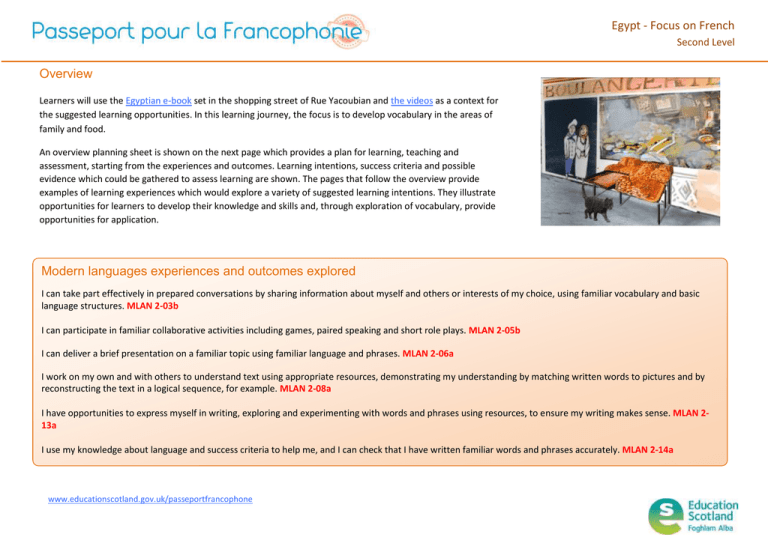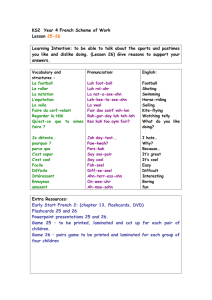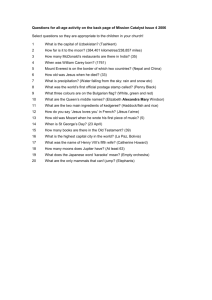Learning Journey Egypt - Focus on French Overview Second Level
advertisement

Egypt - Focus on French Second Level Overview Learners will use the Egyptian e-book set in the shopping street of Rue Yacoubian and the videos as a context for the suggested learning opportunities. In this learning journey, the focus is to develop vocabulary in the areas of family and food. Learning Journey An overview planning sheet is shown on the next page which provides a plan for learning, teaching and assessment, starting from the experiences and outcomes. Learning intentions, success criteria and possible evidence which could be gathered to assess learning are shown. The pages that follow the overview provide examples of learning experiences which would explore a variety of suggested learning intentions. They illustrate opportunities for learners to develop their knowledge and skills and, through exploration of vocabulary, provide opportunities for application. Stirlin g Cas tle 260 Modern languages experiences and outcomes explored I can take part effectively in prepared conversations by sharing information about myself and others or interests of my choice, using familiar vocabulary and basic language structures. MLAN 2-03b I can participate in familiar collaborative activities including games, paired speaking and short role plays. MLAN 2-05b I can deliver a brief presentation on a familiar topic using familiar language and phrases. MLAN 2-06a I work on my own and with others to understand text using appropriate resources, demonstrating my understanding by matching written words to pictures and by reconstructing the text in a logical sequence, for example. MLAN 2-08a I have opportunities to express myself in writing, exploring and experimenting with words and phrases using resources, to ensure my writing makes sense. MLAN 213a I use my knowledge about language and success criteria to help me, and I can check that I have written familiar words and phrases accurately. MLAN 2-14a www.educationscotland.gov.uk/passeportfrancophone Egypt - Focus on French Second Level Overview of learning Experiences and outcomes Learning intentions Success criteria Learning Possible evidenceJourney I work on my own and with others to understand text using appropriate resources, demonstrating my understanding by matching written words to pictures and by reconstructing the text in a logical sequence, for example. MLAN 2-08a To practise using the correct words for the. Family tree Drawing Research notes To learn the words for 6 main family members. I can take part effectively in prepared conversations by sharing information about myself and others or interests of my choice, using familiar vocabulary and basic language structures. MLAN 2-03b I have opportunities to express myself in writing, exploring and experimenting with words and phrases using resources, to ensure my writing makes sense. MLAN 2- To have a conversation about family members. To understand and recognise the main shops in a street. To use the vocabulary that describes shop keepers. 13a I can recognise the difference between masculine, feminine, singular and plural. I can select the correct word for the. I can use vocabulary that describes the members of the family. I can recognise and say ‘I have’, ‘you have’, ‘I don’t have’ and ‘you don’t have’, to talk about relatives and members of my family. I can answer questions about the members of my family. I can talk about shops and shopkeepers. I can write about the shops in my street or in a street of my choice. Family tree Written description I understand that nouns are either masculine or feminine. I can talk about the food I like and don’t like to eat. I can write about the food I like and don’t like to eat. Flash card game Matching activities Participation in game French sentences Oral conversation I can participate in familiar collaborative activities including games, paired speaking and short role plays. MLAN 205b I use my knowledge about language and success criteria to help me, and I can check that I have written familiar words and phrases accurately. MLAN 2-14a To use verbs to express likes and dislikes. I can use the verb aimer (to like). I can use ne ... pas to talk about dislikes. I can use connecting words to join my sentences together. I can deliver a brief presentation on a familiar topic using familiar language and phrases. MLAN 2-06a To talk about food using the words some or any. I can identify the gender and number of nouns and select the correct word for some or any. I can talk about the food I eat for breakfast. To describe food and personal likes and dislikes. www.educationscotland.gov.uk/passeportfrancophone Learner conversation Survey Graph Word bank Presentation Egypt - Focus on French Second Level Challenge 1 Possible tasks Language Introduction Introduce Egypt/Ancient Egypt, linking to eventual studies done in English. Voici = here is In this challenge learners will explore the vocabulary required to describe family members. Learning intentions I will practise using the correct words for the. I will learn the words for six main family members. Ramses’ family tree: - Introduce family members - Voici le père/ la mère/etc… - Repeat / Vrai ou Faux….. - Recap on: Il s’appelle / elle s’appelle… Success criteria Happy Family game. I can recognise the difference between masculine, feminine, singular and plural. Learners could draw their family or a famous family they know, for example The Simpsons. They should label the picture with: - le père - la mère, - la soeur, etc I can select the correct word for the. I can use vocabulary that describes the members of the family. Possible evidence Taking it further Family Tree Drawing Research notes A home learning activity could be for learners to research the following people: - Pharaoh Tutankhamun - Queen Kiya - Pharaoh Akhenaten - Queen Tiye - Pharaoh Amenhotep - Queen Ankhesenatum www.educationscotland.gov.uk/passeportfrancophone Learning Journey Le père = the father Le grand-père = the grandfather Le frère= the brother La mère = the mother La grand-mère = the grandmother La soeur = the sister Il / elle s’appelle… Tu as le / la…. Oui, j’ai le / la…. Non, je n’ai pas le / la…. Knowledge about language Definite article: Le (masculine), la (feminine), les (plural) = the Egypt - Focus on French Second Level Challenge 2 Possible tasks Language Introduction Practitioner recaps language and expands structures: - C’est le père de….? - Qui est le grand-père de… C’est le père de….. ? = Is….the father of……… Learners will discuss their siblings. - Introduce question and answer : Tu as des frères et des soeurs? / Oui, j’ai… Non, e n’ai pas de… - In pairs / group pupils consolidate using minicards. - Introduce demi-frère /demi-soeur / enfant unique as necessary. Tu as des frères et des soeurs ? = Do you have brothers and sisters? Learners as a group could complete a group survey about the number of brothers / sisters they have. They could present their findings as a presentation or in graph form. Learners could report their findings to the rest of the class. Une demi-soeur = a half sister / a step sister In this challenge learners will explore the vocabulary required to describe brothers and sisters. Learning intentions I will have a conversation about family members. Success criteria I can recognise and say ‘I have’, ‘you have’, ‘I don’t have’ and ‘you don’t have’ to talk about relatives and members of my family. I can answer questions about the members of my family. Possible evidence Learner conversation Survey Graph Learning Journey Qui est la soeur de Tutankhamun? = Who is T’s sister? Oui, j’ai un / une… = Yes I have a…. Non. je n’ai pas de………… = No I don’t have any………. Un demi-frère = a half brother / a step brother Un beau-père = a step dad / a father in law Une belle-mère = a step mum / a mother in law Je suis enfant unique = I’m an only child Dans mon groupe, il y a … personnes avec….. frères / soeurs = in my group there are …person with …brothers / sisters… Knowledge about language Indefinite article: Un (masculine), une (feminine), des (plural) = a / some Possessive: No apostrophe used for possessive in French, hence: c’est le……..de……. www.educationscotland.gov.uk/passeportfrancophone Egypt - Focus on French Second Level Challenge 3 Introduction In this challenge learners will explore the vocabulary required to describe shop names. Learning intentions I will understand and recognise the main shops in a street. I will use the vocabulary that describes shop keepers. Success criteria I can talk about shops and shopkeepers. I can write about the shops in my street or in a street of my choice. Introduce the four shops mentioned in the e-book using the flash cards. Practitioners could use the Echo game to focus concentration. The teacher names a shop, learner 1 repeats alone, then learner 2 and after that the whole class repeats. Learners could elicit possible spelling from pupils, referring to relevant previous knowledge: - French alphabet for pronunciation of “i”; où habites-tu /douze for “OU” J’ai 10 ans / janvier for “AN”; onze /marron for “ON” - This helps pupils to recognise patterns and create links between spelling and pronunciation. Flash card activities: - Match Flash cards to written word, focus on article. - Match shops to name of owners. Underline masculine / feminine, focus on article. Possible evidence Language Learning Journey La boucherie = the butcher’s La boulangerie = the baker’s La poissonnerie = the fishmonger’s L’épicerie = the greengrocer’s Le boucher / la bouchère = the butcher (m /f) Le boulanger / la boulangère = the baker (m / f) Le poissonnier / la poissonnière = the fishmonger (m / f) L’épicier / l’épicière = the greengrocer (m / f) Knowledge about language Family tree Written description Listening activities: Possible tasks Taking it further Il habite au numéro = for street number Learners could listen to Egypt e-book about Miou the cat and fill in the family tree. Learners could write about shopkeepers in their street or in their favourite television programme. Sound system focus: do not pronounce the “R” at the end of the shopkeepers’ names unless it is followed by an “e” for the feminine www.educationscotland.gov.uk/passeportfrancophone - Listen to the story and fill in the missing information. J’habite à + town / en (f) au (m) aux (pl) + country Egypt - Focus on French Second Level Challenge 4 Possible tasks Introduction Learners could engage in a game of Hangman or Pictionary to revise shop names. In this challenge learners will explore the vocabulary required to describe shops and items bought in particular shops. Learning intentions I will describe food and personal likes and dislikes. Success criteria I understand that nouns are either masculine or feminine. I can talk about the food I like and don’t like to eat. Possible evidence Flash card game Matching activities Participation in game Learning Journey Le pain = bread Le pâté = pate J’aime le / la / les: - Show a card and pupils sort items into relevant shops, for example: la viande, la boucherie. - Introduce the written words and give learner the opportunity to work out which ones they can readily match (pâté? biscuits?) - Focus on article/gender : hold a card, pupils point to a card, display F / M cards, use whiteboard to write F / M) - Introduce J’aime…. + the items Practitioners could distribute flashcards / props in a circle, 1 person in the middle says: “J’aime le/la…et le/la…”. The “items” named have to get up, there are three people up but only two free chairs, all compete for a seat! The one left in the middle has to come up with a new sentence. “J’aime + two items..” Taking it further Learners could take part in activities such as: Find the odd one out - Sort vocabulary under le / la, - Writing sentences www.educationscotland.gov.uk/passeportfrancophone Language Le poisson = fish Le fromage = cheese Le lait = milk La viande = meat Les crevettes = prawns Les biscuits = biscuits Knowledge of language In this lesson “J’aime” is followed by the definite article (le / la / les) If you were ordering, you could use either: - the indefinite article. For example: Je voudrais un pain (units) or - the partitive, for example: je voudrais de la viande (some) (See learning experiences part 6) Egypt - Focus on French Second Level Language Challenge 5 Introduction In this challenge learners will explore the vocabulary required to build longer sentences. Learning intentions I will use verbs to express likes and dislikes. Success criteria I can use the verb: aimer (to like). I can use: ne ... pas to talk about dislikes. I can use connecting words to join my sentences together. Possible evidence French sentences Oral conversation Possible tasks Practitioners could revisit: - days of the week + song - association + numbers 1-7 - Say a day, pupils identify matching shop from story / food the cat eats on that day www.educationscotland.gov.uk/passeportfrancophone Introduce: Je n’aime pas. - Build longer sentences. (Extend to whole verb for 3rd level) - Recycle vocab from previous learning eg: j’aime le rouge / je n’aime pas le vert , j’aime le foot / je n’aime pas le tennis, j’aime les livres / je n’aime pas la télévision. - Introduce connectors like: et / mais / aussi. J’aime le fromage et aussi le pâté. J’aime le rugby mais je n’aime pas le golf. Je préfère….might arise naturally or be introduced later as suitable. - Consider :“j’aime bien / j’aime beaucoup” or “je n’aime pas ……..non plus” - Practice orally with small cards / props (1 heart = J’aime, crossed heart = Je n’aime pas) - Extension work: throw a dice 1-6 for pronoun practice: 1 = je, 2 = tu, 3 = il/elle/on, 4 = nous, 5 = vous, 6 = ils/elles - Learners try to make as many sentences as they can in groups in a given time. Support can be offered with words stuck on blocks to visualise building the sentence. Learning Journey Revisit previous learning as suitable Et = and Mais = but Aussi = as well Non plus = neither (use with negative ) Je n’aime pas = I don’t like Je préfère = I prefer J’aime bien = I like J’aime beaucoup = I like ….a lot Knowledge about language Er verbs: Aimer = to like = infinitive Taking it further Learner could complete an activity where they decipher a pictogram and write sentences. To get the stem, remove the ER, then add relevant endings: J’ aime Nous aimons Tu aimes vous aimez Il/ elle/ on aime Ils / elles aiment Egypt - Focus on French Second Level Challenge 6 Introduction In this challenge learners will explore the vocabulary required to build longer sentences, to discuss what foods they eat. Learning intentions I will talk about food using the words ‘some’ or ‘any’. Success criteria I can identify the gender and number of nouns and select the correct word for ‘some’ or ‘any’. I can talk about the food I eat for breakfast. Possible evidence Word bank Presentation Possible tasks Practitioners could explore the last paragraph in the e-book talking script. www.educationscotland.gov.uk/passeportfrancophone Partitive / expressing “some” activities: - Recap on: le, la and les - Introduce the words for some and any o Du fromage – some/any cheese (masc) o De la viande – some/any meat (fem) o Des biscuits – some/any biscuits (plural) Learners could take part in a dictionary / culture activity. Read about Egyptians’ typical breakfast and create their own word bank. Using a dictionary, learners could list what they have for breakfast. Use your notes to discuss what everyone has at breakfast in your group. For example: - Qu’est-ce que tu manges au petit déjeuner ? - Je mange des céréales, du pain et de la confiture avec du café. Taking it further Learners could prepare a short presentation on a traditional Scottish breakfast / what you have for breakfast / the class’ most popular breakfast. Language Learning Journey Je mange = I eat Tu manges = you eat Il / elle mange = he / she eats Du + masculine item = some De la + feminine item = some De l’ + noun starting with a vowel sound = some Des + plural items = some Knowledge about language In French you must use “some” even in sentences where in English “some” is only implied as in: He eats (some) fish. He would like (some) cheese. I eat (some) jam at breakfast. Unless you are being specific, definite, about which item you want.





